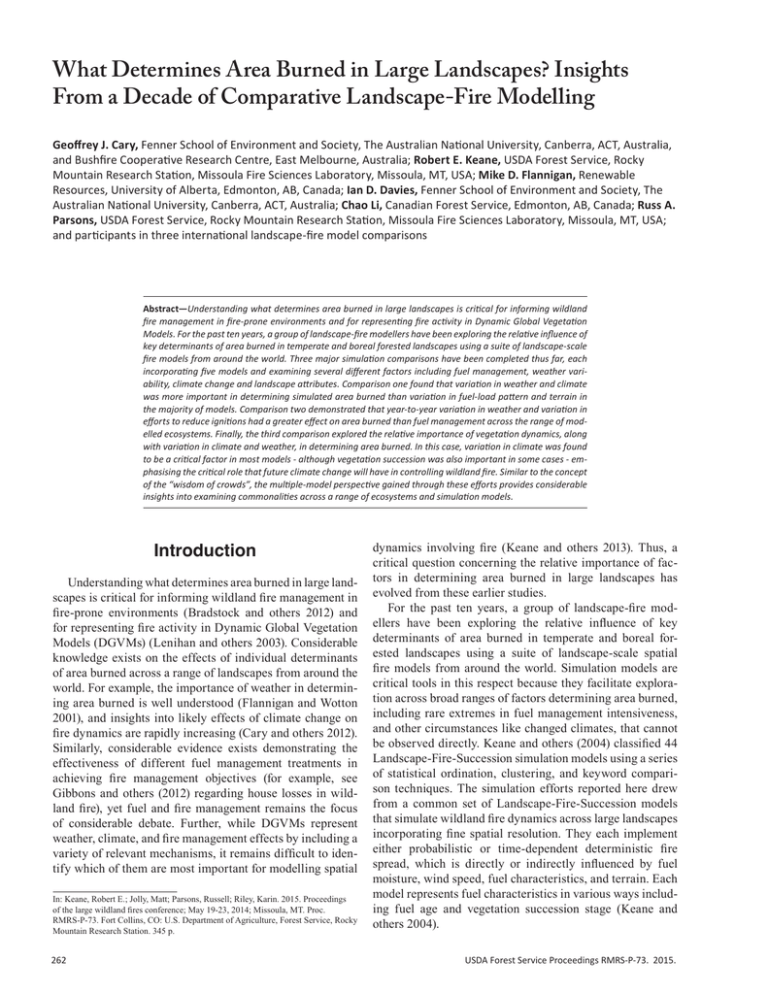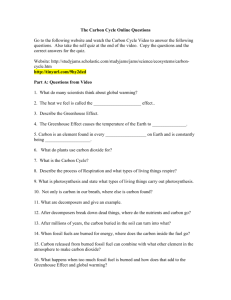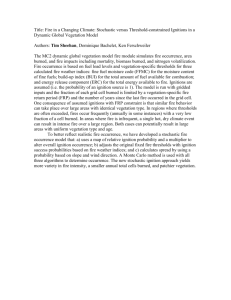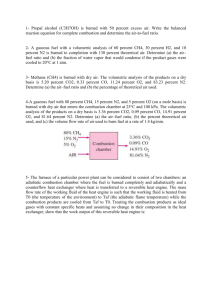What Determines Area Burned in Large Landscapes? Insights
advertisement

What Determines Area Burned in Large Landscapes? Insights From a Decade of Comparative Landscape-Fire Modelling Geoffrey J. Cary, Fenner School of Environment and Society, The Australian National University, Canberra, ACT, Australia, and Bushfire Cooperative Research Centre, East Melbourne, Australia; Robert E. Keane, USDA Forest Service, Rocky Mountain Research Station, Missoula Fire Sciences Laboratory, Missoula, MT, USA; Mike D. Flannigan, Renewable Resources, University of Alberta, Edmonton, AB, Canada; Ian D. Davies, Fenner School of Environment and Society, The Australian National University, Canberra, ACT, Australia; Chao Li, Canadian Forest Service, Edmonton, AB, Canada; Russ A. Parsons, USDA Forest Service, Rocky Mountain Research Station, Missoula Fire Sciences Laboratory, Missoula, MT, USA; and participants in three international landscape-fire model comparisons Abstract—Understanding what determines area burned in large landscapes is critical for informing wildland fire management in fire-prone environments and for representing fire activity in Dynamic Global Vegetation Models. For the past ten years, a group of landscape-fire modellers have been exploring the relative influence of key determinants of area burned in temperate and boreal forested landscapes using a suite of landscape-scale fire models from around the world. Three major simulation comparisons have been completed thus far, each incorporating five models and examining several different factors including fuel management, weather variability, climate change and landscape attributes. Comparison one found that variation in weather and climate was more important in determining simulated area burned than variation in fuel-load pattern and terrain in the majority of models. Comparison two demonstrated that year-to-year variation in weather and variation in efforts to reduce ignitions had a greater effect on area burned than fuel management across the range of modelled ecosystems. Finally, the third comparison explored the relative importance of vegetation dynamics, along with variation in climate and weather, in determining area burned. In this case, variation in climate was found to be a critical factor in most models - although vegetation succession was also important in some cases - emphasising the critical role that future climate change will have in controlling wildland fire. Similar to the concept of the “wisdom of crowds”, the multiple-model perspective gained through these efforts provides considerable insights into examining commonalities across a range of ecosystems and simulation models. Introduction Understanding what determines area burned in large landscapes is critical for informing wildland fire management in fire-prone environments (Bradstock and others 2012) and for representing fire activity in Dynamic Global Vegetation Models (DGVMs) (Lenihan and others 2003). Considerable knowledge exists on the effects of individual determinants of area burned across a range of landscapes from around the world. For example, the importance of weather in determining area burned is well understood (Flannigan and Wotton 2001), and insights into likely effects of climate change on fire dynamics are rapidly increasing (Cary and others 2012). Similarly, considerable evidence exists demonstrating the effectiveness of different fuel management treatments in achieving fire management objectives (for example, see Gibbons and others (2012) regarding house losses in wildland fire), yet fuel and fire management remains the focus of considerable debate. Further, while DGVMs represent weather, climate, and fire management effects by including a variety of relevant mechanisms, it remains difficult to identify which of them are most important for modelling spatial In: Keane, Robert E.; Jolly, Matt; Parsons, Russell; Riley, Karin. 2015. Proceedings of the large wildland fires conference; May 19-23, 2014; Missoula, MT. Proc. RMRS-P-73. Fort Collins, CO: U.S. Department of Agriculture, Forest Service, Rocky Mountain Research Station. 345 p. 262 dynamics involving fire (Keane and others 2013). Thus, a critical question concerning the relative importance of factors in determining area burned in large landscapes has evolved from these earlier studies. For the past ten years, a group of landscape-fire modellers have been exploring the relative influence of key determinants of area burned in temperate and boreal forested landscapes using a suite of landscape-scale spatial fire models from around the world. Simulation models are critical tools in this respect because they facilitate exploration across broad ranges of factors determining area burned, including rare extremes in fuel management intensiveness, and other circumstances like changed climates, that cannot be observed directly. Keane and others (2004) classified 44 Landscape-Fire-Succession simulation models using a series of statistical ordination, clustering, and keyword comparison techniques. The simulation efforts reported here drew from a common set of Landscape-Fire-Succession models that simulate wildland fire dynamics across large landscapes incorporating fine spatial resolution. They each implement either probabilistic or time-dependent deterministic fire spread, which is directly or indirectly influenced by fuel moisture, wind speed, fuel characteristics, and terrain. Each model represents fuel characteristics in various ways including fuel age and vegetation succession stage (Keane and others 2004). USDA Forest Service Proceedings RMRS-P-73. 2015. Table 1—Landscape-fire-succession models included in one or more model comparisons indicating general location, indicative vegetation types, inclusion in model comparisons and key reference. Model EMBYR SEM-LAND FIRESCAPE LAMOS LANDSUM CAFÉ FIRE-BGC FS-SWT Location Western USA Western Canada Southeast Australia Generic Western USA Southeast Australia Western USA Southeast Australia Vegetation Lodgepole pine (LP) Boreal forest Eucalyptus forest Generic LP – Douglas fir (DF) Eucalyptus woodland LP – DF Grass/scrub/forest Here we summarise the three major simulation comparisons that have been completed thus far, each incorporating at least five models and examining the relative importance of several different factors, including fuel management, weather variability, climate change and landscape attributes. Our objective here is to highlight findings that emerged from considering all of the comparisons together. The model comparison work was initiated under the Global Change and Terrestrial Ecosystems project (GCTE Task 2.2.2), and has since been supported by a range of agencies (see acknowledgements) and simulation modellers from Australia, Canada, and the USA. Synthesis of Modelling Studies Each model comparison experiment involved a standardized design for simulating area burned in five landscape-fire-succession models. Due to logistical constraints, the subset of models varied somewhat from one comparison to the next; however, we maintained a common core of modellers throughout and three models were included in all three comparison experiments (table 1). In the comparisons, models incorporated vegetation dynamics and relevant climate (table 1) for the location in which they were originally verified and validated before the application of experimental treatments in this study. Each comparison involved simulating annual area burned across all combinations of factors included in that comparison (table 2) (Cary and others 2006, 2009; Keane and others 2013). Simulation landscapes were comprised of 1,000 by 1,000 pixels that were each 50 by 50 m in size, for a total of 50 by 50 km. Variation in area burned explained by each factor, and all subsequent interactions between factors, were quantified by the Relative Sum of Squares (R2) for factors and interactions in a Generalized Linear Model analysis of simulated area burned, after appropriate data transformations were applied. This analysis highlights the importance of factors contributing to area burned within each model, however variation in area burned between models was not formally investigated. Instead, our objective in each comparison was to evaluate consensus, or lack thereof, in importance of factors controlling area burned across the various models. We assumed that a factor could be regarded as important if it explained greater than five percent of total variation in area burned in a model (Cary and others 2006). Overall, around half of the USDA Forest Service Proceedings RMRS-P-73. 2015. Comparison Key reference 1 1 2 1 2 3 1 2 3 1 2 3 2 3 3 Hargrove and others 2000 Li 2000 Cary and Banks 2000 Lavorel and others 2000 Keane and others 2006 Bradstock and others 1998 Keane and others 2011 King and others 2006 combinations of the unique factor/model combinations were regarded as important when considering the three comparisons collectively. Comparison one (Cary and others 2006) involved investigating variation in area burned that resulted from single year simulations across all combinations of: (i) mountainous, rolling or flat landscapes (Terrain); (ii) finely clumped or coarsely-clumped fuel pattern, with ten equally represented levels of fuel load or succession stage being linearly scaled from zero to a maximum value in initial simulation landscapes (Fuel pattern); (iii) observed climate, warmer-wetter climate, or warmer-drier climate (Climate); and (iv) ten different weather years selected from the historical weather record (Weather I) (see table 2 for details on factors). Results indicated that variation in weather and climate was more important in determining simulated area burned than was variation in fuel pattern and terrain in the majority of models (table 3). Year-to-year variability in weather (Weather I) resulted in considerable variation in area burned. Warmer climates, including in some cases those that were also wetter, resulted in large increases in area burned compared with historical climates (Cary and others 2006). These findings suggest that representing changes in climate variability (represented here by the weather factor) is as important as incorporating climate change in landscape-level and global models that include fire dynamics. Conversely, fuel pattern was not a major factor, suggesting that inclusion of fine-scale vegetation patterns in coarser models such as DGVMs may be unnecessary. Building upon insights from the first experiment, Comparison two (Cary and others 2009) added factors more specific to fire management, including: (i) patterns of fuel treatment (Fuel management approach); (ii) amount of landscape involved in fuel treatments (Fuel management effort); (iii) proportion of simulated ignitions supressed (Ignition management effort); and (iv) different weather years selected from the historical weather record (Weather I) (table 2). In all models, variation in ignition management, from zero to 75 percent of ignitions prevented, and variation in weather (Weather I), were found to be more important in determining area burned than fuel management (less than five percent of variation in area burned explained) (table 4) (Cary and others 2009). This comparison reconfirmed the overriding importance of weather, and highlighted the critical role of ignition management, in determining area burned. Worth noting is that our definition of high ignition management effort 263 Table 2—Overview of factors included in one or more model comparisons indicating inclusion in model comparisons, number of levels, and brief indication of each level. See Cary and others (2006, 2009), and Keane and others (2013) for details. Factor Comparison Levels Description of levels Terrain 1 Three Mountainous: 0 – 2,500 m elevation range; 30o maximum slope Rolling: 625 – 1,875 m elevation range; 15o maximum slope Flat: 1,250 m elevation; 0o maximum slope Fuel pattern 1 Two Fine: 25 ha square patches of fuel ages in initial landscape Coarse: 625 ha square patches of fuel ages in initial landscape Weather I 1 2 Ten 10 distinct years of daily weather reflecting observed variability in mean annual temperature and precipitation in observed weather record for each location Climate 1 3 Three Observed: Historical climate for each location Warmer/Wetter: Historical; + 3.6o C; + 20 percent precipitation Warmer/Drier: Historical; + 3.6o C; - 20 percent precipitation Fuel management 2 Three approach Random fuel treatment Fuel management 2 Four effort Narrow edge fuel treatment Buffer fuel treatment In each example, areas with fuel treatment (black colour) are located in or around a matrix of areas with untreated fuel (grey colour) Zero: 0 percent of landscape treated Low: 10 percent treated (Random); 100 m (Buffer); 50 m (Edge) Mod.: 20 percent treated (Random); 200 m (Buffer); 100 m (Edge) High: 30 percent treated (Random); 300 m (Buffer); 150 m (Edge) Ignition management 2 Four effort Zero: 0 percent of ignitions prevented Low: 25 percent of ignitions prevented Mod.: 50 percent of ignitions prevented High: 75 percent of ignitions prevented Vegetation succession 3 Two Static: Landscape does not age; fire does not effect vegetation Dynamic: All successional dynamics simulated Weather II 3 Two Entire: Long-term sequences of daily weather incorporating historical inter-annual variability Constant: Sequences of daily weather from five ‘median’ years Table 3—Results of model comparison one indicating factors considered important (•) in explaining variation in simulated area burned (Relative Sum of Squares > 0.05 in a Generalised Linear Modelling analysis) for five landscape-fire-succession models. Importance is indicated for factors (Terrain, Fuel pattern, Climate, Weather I) only. Importance of interactions among factors, while evaluated, is not displayed. Modified from Cary and others (2006). Source of variation EMBYR Terrain Fuel pattern • Climate Weather I • 264 FIRESCAPE Model LAMOS LANDSUM SEM-LAND • • • • • • • • USDA Forest Service Proceedings RMRS-P-73. 2015. Table 4—Results of model comparison two indicating factors considered important (•) in explaining variation in simulated area burned (Relative Sum of Squares > 0.05 in a Generalised Linear Modelling analysis) for five landscape-fire-succession models. Importance is indicated for factors (Fuel management approach, Fuel management effort, Ignition management effort, Weather I) only. Importance of interactions among factors, while evaluated, is not displayed. Modified from Cary and others (2009). Source of variation Model CAFÉ FIRESCAPE LAMOS(HS) Fuel mgmt approach Fuel mgmt effort Ignition mgmt Weather I • • • • LANDSUM SEM-LAND • • • • • • Table 5—Results of model comparison three indicating factors considered important (•) in explaining variation in simulated area burned (Relative Sum of Squares > 0.05 in a Generalised Linear Modelling analysis) for five landscape-fire-succession models. Importance is indicated for factors (Succession, Climate, Weather II) only. Importance of interactions among factors, while evaluated, is not displayed. Modified from Keane and others (2013). Source of variation FIRE-BGC FIRESCAPE Succession Climate • • Weather II Model FS-SWT LAMOS(HS) LANDSUM • • • • • • equating to 75 percent of ignitions being prevented is arguably conservative, with frequency of fire containment on initial attack higher than this for some landscapes (Arienti and others 2006), and thus we may have underestimated the importance of ignition management overall. The first two comparisons were conducted using singleyear simulation runs that did not invoke vegetation succession or fuel development through time. Comparison three (Keane and others 2013) addressed temporal fuel changes through simulation runs corresponding to the length of each model’s ‘succession cycle’, which varied from 10 – 450 years, depending on the nature of fuel and vegetation dynamics implemented in each case. Here we explored effects on average annual area burned of combinations of: (i) static or dynamic vegetation succession and fuel development (Succession); (ii) observed climate, warmer-wetter climate, or warmer-drier climate (Climate); and (iii) long-term sequences of daily weather data that fully incorporated historical inter-annual variability, or more restricted sequences of daily weather drawn only from five median weather years (Weather II) (table 2). In this comparison, variation in climate was an important factor in determining simulated area burned in four models while vegetation succession alone was an important factor in three out of five cases (table 5). Interestingly, the weather factor, which was implemented differently in this experiment, was no longer found to be important for long-term average area burned in the majority of models. In this case, variation in weather (Weather II) was introduced by looping through either the entire daily weather record for a model (typically 30 – 40 years), or looping through daily records from the five years with mean annual temperature and precipitation values closest to the overall climatic means. In both cases, the long-term mean annual temperature and precipitation were approximately the same. In comparison one and two, by way of contrast, the USDA Forest Service Proceedings RMRS-P-73. 2015. weather treatment (Weather I) was comprised of ten separate years of daily weather, thus incorporating large differences in mean annual temperature and precipitation for different sets of simulation runs, and effectively introducing an additional level of climatic change. Comparison three suggests that, for long simulation runs, intra-annual variability in weather is playing a greater role than inter-annual variability, in explaining simulated area burned. Conclusions A series of multi-model comparisons have demonstrated that variation in climate, commensurate with climatic shifts expected in a future, warmer world, is consistently important in determining area burned in large landscapes compared with other factors. Individual years, characterised by weather that is on average warmer and drier or cooler and wetter than mean values will also result in significant additional variation in area burned. However, for long simulations, the extent of inter-annual weather variation is apparently less important than intra-annual variability for variation in area burned over longer periods. Fuel pattern and fuel management was consistently found to be largely unimportant in determining variation in area burned in large landscapes. On the other hand, greater ignition management effort—representing all activities that minimize or prevent ignitions including education programs, fire bans and rapid initial attack of fires—had an important effect across all models, underscoring its roles in contemporary wildland fire management. Simulation of wildland fire dynamics is a wellestablished research field. However, we propose that our ensemble approach, comprised of standardised comparisons across multiple drivers of fire and multiple models, has 265 provided robust new insights into what determines area burned in large landscapes. Similar to the concept of the “wisdom of crowds” (Galton 1907; Surowiecki 2005), the multiple-model perspective gained through these efforts provides considerable insights into examining commonalities across a range of ecosystems and simulation models. Acknowledgments We gratefully acknowledge Dr. Trent Penman and Dr. Marta Yebra who provided highly constructive feedback on our manuscript. We also gratefully acknowledge additional funding and other support from: The National Center for Ecological Analysis and Synthesis, USA; The Bushfire Cooperative Research Centre, Australia; NASA’s Earth Science Applications Division, USA; The Program for Energy Research and Development (PERD) of Natural Resources Canada; The US National Fire Plan; The Joint Fire Science Program, USA; and The National Science Foundation funded Wildfire-PIRE project, USA. References Arienti, M. Cecilia; Cumming, Steven G.; Boutin, Stan. 2006. Empirical models of forest fire attack success probabilities: the effects of fuels, anthropogenic linear features, fire weather, and management. Canadian Journal of Forest Research. 36: 3155-3166. Bradstock, Ross A.; Bedward, Michael; Kenny, Belinda J.; Scott, J. 1998. Spatially explicit simulation of the effect of prescribed burning on fire regimes and plant extinctions in shrublands typical of south-eastern Australia. Biological Conservation. 86: 83–95. Bradstock, Ross A.; Cary, Geoffrey J.; Davies, Ian; Lindenmayer, David B.; Price, Owen F.; Williams, Richard J. 2012. Wildfires, fuel treatment and risk mitigation in Australian eucalypt forests: insights from landscape-scale simulation. Journal of Environmental Management. 105: 66-75. Cary, Geoffrey J.; Banks, John C.G. 2000. Fire regime sensitivity to global climate change: an Australia perspective. In: Innes, J.L.; Beniston, M.; Verstraete, M.M., eds. Biomass Burning and its Inter-relationships with the Climate System. Advances in Global Change Research, Vol. 3. Kluwer Academic Publishers. London, UK: 233–246. Cary, Geoffrey J.; Keane, Robert E.; Gardner, Robert H.; Lavorel, Sandra; Flannigan, Mike D.; Davies, Ian D.; Li, Chao; Lenihan, James M.; Rupp, T. Scott; Mouillot, Florent. 2006. Comparison of the sensitivity of landscape-fire-succession models to variation in terrain, fuel pattern, climate and weather. Landscape Ecology. 21: 121–37. Cary, Geoffrey J.; Flannigan, Mike D.; Keane, Robert E.; Bradstock, Ross A.; Davies, Ian D.; Lenihan, James M.; Li, Chao; Logan, Kimberley A.; Parsons, Russell A. 2009. Relative importance of fuel management, ignition management and weather for area burned: Evidence from five landscape-fire-succession models. International Journal of Wildland Fire. 18: 147–56. The content of this paper reflects the views of the authors, who are responsible for the facts and accuracy of the information presented herein. 266 Cary, Geoffrey J.; Bradstock, Ross A.; Gill, A. Malcolm; Williams, Richard J. 2012. Global change and fire regimes in Australia. In: Bradstock, R.A.; Gill, A.M.; Williams, R.J., eds. Flammable Australia: Fire Regimes, Biodiversity and Ecosystems in a Changing World. CSIRO Publishing. Melbourne, VIC: 149–169 (ISBN 9780643104822) Flannigan, Mike D.; Wotton, B. Mike. 2001. Climate, weather and area burned. In: Johnson, E.; Miyanishi, K. eds. Forest Fires: Behaviour and Ecological Effects. Kluwer Academic Press. San Diego, CA: 335–357. Galton, Francis. 1907. Vox populi. Nature. 75: 450-451. Gibbons, Philip; Van Bommel, Linda; Gill, A. Malcolm; Cary, Geoffrey J.; Driscoll, Don D.; Bradstock, Ross A.; Knight, Emma; Moritz, Max A.; Stephens, Scott L.; Lindenmayer, David B. 2012. Land management practices associated with house loss in wildfires. PLoS ONE. 7 (1): e29212 Hargrove, William W.; Gardner, Robert, H.; Turner, Monica G.; Romme, William H.; Despain, Don G. 2000. Simulating fire patterns in heterogeneous landscapes. Ecological Modelling. 135: 243–263. Keane, Robert E.; Cary, Geoffrey J.; Davies, Ian D.; Flannigan, Mike D.; Gardner, Robert H.; Lavorel, Sandra; Lenihan, James M.; Li, Chao; Rupp, T. Scott. 2004. A classification of landscape fire succession models: spatial simulations of fire and vegetation dynamics. Ecological Modelling. 179: 3–27. Keane, Robert E., Holsinger, Lisa M., Pratt, Sarah D. 2006. Simulating historical landscape dynamics using the landscape fire succession model LANDSUM version 4.0. General Technical Report RMRSGTR-171CD. USDA Forest Service Rocky Mountain Research Station, Fort Collins, CO, USA. 73 p. Keane, Robert E., Loehman, Rachel A., Holsinger Lisa M. 2011. The FireBGCv2 landscape fire and succession model: a research simulation platform for exploring fire and vegetation dynamics. General Technical Report RMRS-GTR-255. U.S. Department of Agriculture, Forest Service, Rocky Mountain Research Station, Fort Collins, CO, USA. 137 p. Keane, Robert E.; Cary, Geoffrey J.; Flannigan, Mike D.; Parsons, Russell A.; Davies, Ian D.; King, Karen J.; Li, Chao; Bradstock, Ross A.; Gill, A. Malcolm. 2013. Exploring the role of fire, succession, climate, and weather on landscape dynamics using comparative modeling. Ecological Modelling. 266: 172-186. King, Karen J.; Cary, Geoffrey J.; Bradstock, Ross A.; Chapman, Joanne; Pyrke, Adrian; Marsden-Smedley, Jon. 2006. Simulation of prescribed burning strategies in south-west Tasmania, Australia: effects on unplanned fires, fire regimes, and ecological management values. International Journal of Wildland Fire. 15: 527–540. Lavorel, Sandra; Davies, Ian D.; Noble, Ian R. 2000. LAMOS: A LAndscape MOdelling Shell. In: Hawkes, B.C.; Flannigan, M.D. eds. Landscape Fire Modelling-Challenges and Opportunities. Northern Forestry Centre Information Report NOR-X-371. Natural Resources Canada, Canadian Forest Service Edmonton, Alberta, AB: 25–28. Lenihan, James M.; Drapek, Raymond; Bachelet, Dominique; Neilson, Ronald P. 2003. Climate change effects on vegetation distribution, carbon and fire in California. Ecological Applications. 13: 1667-1681. Li, Chao. 2000. Reconstruction of natural fire regimes through ecological modelling. Ecological Modelling. 134: 129–144. Surowiecki, James. 2005. The Wisdom of Crowds. Anchor Books. New York, NY. ISBN 0385721706 USDA Forest Service Proceedings RMRS-P-73. 2015.






